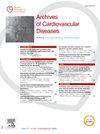Early Post-Hospital Complications of left-sided infective endocarditis: Data from the EIPSL Cohort
IF 2.2
3区 医学
Q2 CARDIAC & CARDIOVASCULAR SYSTEMS
引用次数: 0
Abstract
Background
Infective endocarditis (IE) is a severe disease with high mortality. While in-hospital management is well defined, follow-up after discharge remains less established. Significant complications can occur following hospitalization for IE and a standardized follow-up may allow early detection and management.
Objectives
This study aimed to describe the prevalence and characteristics of complications of left-sided IE within 6 ± 3 months after discharge and evaluate the impact of early screening on patient management.
Methods
From September, 2020, to April, 2024, all surviving patients after an hospitalization for left-sided IE at Pitié-Salpêtrière Hospital were prospectively included. At discharge, a systematic follow-up, including a medical consultation, blood tests and an echocardiography, has been scheduled at 1 and 6 ± 3 months.
Results
During the study period, 311 patients were treated for left-sided IE with an in-hospital mortality rate of 22%, the 242 survivors were included (Table 1). The mean age was 65 ± 15 years, 45% had prosthetic valve IE, and 57% underwent surgery. The recommended follow-up was completed by 210 (87%) patients (median time, 6[3–8] months).
A total of 77 (32%) patients experienced complications (Table 2), including recurrent IE (n = 8), periprosthetic leaks (n = 7), paravalvular pseudoaneurysms (n = 8), significant regurgitation (n = 17), and stroke (n = 8). Notably, 43 (56%) patients were asymptomatic at diagnosis. Thanks to systematic follow-up, among the 15 patients who required cardiac surgery, 10 patients were operated at an early asymptomatic stage. The global mortality rate was 10% but mortality was significantly higher among patients who missed the scheduled examinations (13/32; 41% vs. 12/210; 6% in rest of the cohort; P < 0.0001).
Conclusion
Standardized follow-up after left-sided IE frequently identifies early post-hospital complications, often in asymptomatic patients. Early detection seems to positively impact management and could improve prognosis.
左侧感染性心内膜炎的早期院后并发症:来自EIPSL队列的数据
背景:有效性心内膜炎(IE)是一种病死率高的严重疾病。虽然院内管理明确,但出院后的随访仍不完善。IE住院后可能出现严重并发症,标准化的随访可能有助于早期发现和管理。目的了解左侧IE患者出院后6±3个月内并发症的发生率及特点,评价早期筛查对患者管理的影响。方法前瞻性纳入2020年9月至2024年4月在Pitié-Salpêtrière医院住院治疗左侧IE的所有存活患者。出院时进行系统随访,包括1个月和6±3个月的医疗咨询、血液检查和超声心动图检查。结果在研究期间,311例左侧IE患者接受治疗,住院死亡率为22%,242例幸存者被纳入(表1)。平均年龄65±15岁,45%行人工瓣膜IE, 57%行手术。210例(87%)患者完成了推荐的随访(中位时间6[3-8]个月)。共有77例(32%)患者出现并发症(表2),包括复发性IE (n = 8)、假体周围渗漏(n = 7)、瓣旁假性动脉瘤(n = 8)、严重反流(n = 17)和中风(n = 8)。值得注意的是,43例(56%)患者在诊断时无症状。通过系统随访,在15例需要心脏手术的患者中,有10例患者在早期无症状阶段进行了手术。全球死亡率为10%,但错过预定检查的患者死亡率明显更高(13/32;41% vs. 12/210;其余人群占6%;P & lt;0.0001)。结论左侧IE术后标准化随访可发现早期院后并发症,多见于无症状患者。早期发现似乎对治疗有积极影响,并能改善预后。
本文章由计算机程序翻译,如有差异,请以英文原文为准。
求助全文
约1分钟内获得全文
求助全文
来源期刊

Archives of Cardiovascular Diseases
医学-心血管系统
CiteScore
4.40
自引率
6.70%
发文量
87
审稿时长
34 days
期刊介绍:
The Journal publishes original peer-reviewed clinical and research articles, epidemiological studies, new methodological clinical approaches, review articles and editorials. Topics covered include coronary artery and valve diseases, interventional and pediatric cardiology, cardiovascular surgery, cardiomyopathy and heart failure, arrhythmias and stimulation, cardiovascular imaging, vascular medicine and hypertension, epidemiology and risk factors, and large multicenter studies. Archives of Cardiovascular Diseases also publishes abstracts of papers presented at the annual sessions of the Journées Européennes de la Société Française de Cardiologie and the guidelines edited by the French Society of Cardiology.
 求助内容:
求助内容: 应助结果提醒方式:
应助结果提醒方式:


